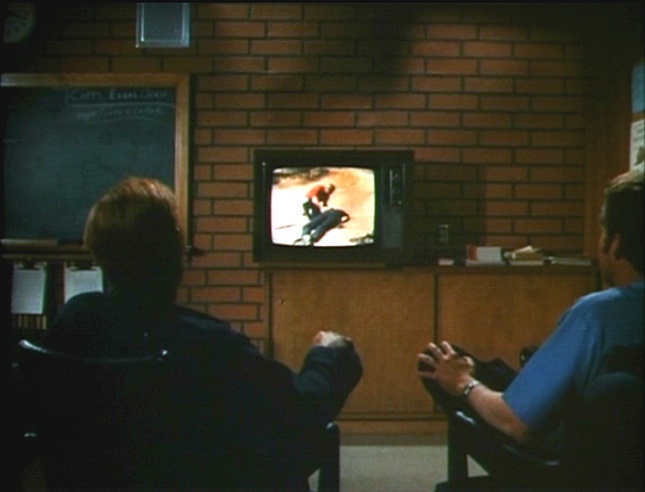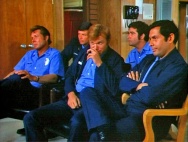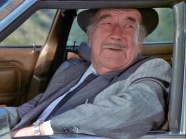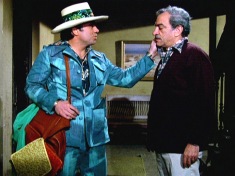As a companion piece to last week’s post, here are ten shows I liked. They’re not the greatest shows. They’re not even necessarily among my top favorites. But each of them turned out to be a lot better than I expected.
……………………………………………………….
 Bat Masterson (1958-1961) – A surprisingly slick-looking western from Ziv, with far better-looking costumes and sets than you’ll find in the typical TV oater, Bat Masterson is a real standout. As played by Gene Barry, Bat is an unusual western hero. He’s a cultured gentleman in the William Powell tradition, roaming the West and finding adventure everywhere. He’d rather dispatch the villain with one swing of his silver-tipped walking cane than with a six-shooter, and he’d rather beat a crook at his own game than simply call for the sheriff to arrest him. Barry plays nearly every scene with a twinkle in his eye, and although I tend to prefer two-fisted westerns, Bat Masterson is an unexpected delight, thanks largely to the finesse of his confident, genial performance. It’s the ideal western for people who normally don’t care for westerns (which seems to be nearly everybody these days), and for western fans who are ready for a fresh approach.
Bat Masterson (1958-1961) – A surprisingly slick-looking western from Ziv, with far better-looking costumes and sets than you’ll find in the typical TV oater, Bat Masterson is a real standout. As played by Gene Barry, Bat is an unusual western hero. He’s a cultured gentleman in the William Powell tradition, roaming the West and finding adventure everywhere. He’d rather dispatch the villain with one swing of his silver-tipped walking cane than with a six-shooter, and he’d rather beat a crook at his own game than simply call for the sheriff to arrest him. Barry plays nearly every scene with a twinkle in his eye, and although I tend to prefer two-fisted westerns, Bat Masterson is an unexpected delight, thanks largely to the finesse of his confident, genial performance. It’s the ideal western for people who normally don’t care for westerns (which seems to be nearly everybody these days), and for western fans who are ready for a fresh approach.
……………………………………………………………………..
 I Led 3 Lives (1953-1956) – What circulates of this show is sold under the counter from collector/dealers, and the image quality isn’t as good as I’d like. But it’s strangely compelling, presenting the adventures of “Comrade Herb” Philbrick and his dealings with communist subversives in Eisenhower’s Middle America. Our traitor is actually working for the FBI, gathering information and passing it along so the bad guys can be rounded up (typically just as they’re on the verge of discovering his identity and killing him). The show was produced by Ziv right alongside Highway Patrol, which instantly became a durable favorite in syndication. But I Lived 3 Lives collapsed into obscurity, as anti-communism gradually became something most Americans snickered at. Maybe the show got silly later on, but the episodes I’ve seen are surprisingly suspenseful, and vastly more interesting than the avalanche of “secret agent” shows that came along a decade later. I Led 3 Lives was based on a book by the real-life Herbert Philbrick, who really was an undercover operative for the FBI and really did help bring down enemy agents, and those realities keep the show (however barely) from descending into camp self-parody. It’s easy to be amused today, watching Joe Friday lecture hippies on Dragnet about the dangers of marijuana, but the historical reality behind I Led 3 Lives insulates it from the same condescension… somewhat.
I Led 3 Lives (1953-1956) – What circulates of this show is sold under the counter from collector/dealers, and the image quality isn’t as good as I’d like. But it’s strangely compelling, presenting the adventures of “Comrade Herb” Philbrick and his dealings with communist subversives in Eisenhower’s Middle America. Our traitor is actually working for the FBI, gathering information and passing it along so the bad guys can be rounded up (typically just as they’re on the verge of discovering his identity and killing him). The show was produced by Ziv right alongside Highway Patrol, which instantly became a durable favorite in syndication. But I Lived 3 Lives collapsed into obscurity, as anti-communism gradually became something most Americans snickered at. Maybe the show got silly later on, but the episodes I’ve seen are surprisingly suspenseful, and vastly more interesting than the avalanche of “secret agent” shows that came along a decade later. I Led 3 Lives was based on a book by the real-life Herbert Philbrick, who really was an undercover operative for the FBI and really did help bring down enemy agents, and those realities keep the show (however barely) from descending into camp self-parody. It’s easy to be amused today, watching Joe Friday lecture hippies on Dragnet about the dangers of marijuana, but the historical reality behind I Led 3 Lives insulates it from the same condescension… somewhat.
……………………………………………………………………..
 Jake and the Fatman (1987-1992) – Admittedly I’ve only seen the earliest episodes, but you can’t blame me for that; CBS DVD released only the first two seasons (a scant 32 episodes combined) before giving up and locking the vault. The majority of the show’s episodes are out of view, and even the bootleggers don’t seem to have them. I began watching the first season on the hunch that it’d be worth a try. After all, I already loved William Conrad from Cannon and radio’s Gunsmoke, so I knew he wouldn’t disappoint as a cranky prosecutor in Jake and the Fatman— and he doesn’t. The really pleasant surprises are Joe Penny as his suave investigative cohort, and the brisk, witty scripts. Wisely, the producers leave all the legwork to Penny; half of the corpulent Conrad’s scenes are delivered while sitting down or leaning against the witness stand. He could be fairly spry back in his Cannon days, but by this point he’s very heavy, and I bet he waddles across a courtroom pretty slowly in these final seasons. During its original run, Jake and the Fatman was regularly paddled in the ratings by the likes of Night Court and Doogie Howser, M.D.; it also underwent a second-season change of locale, and some turbulence in the producers’ office. In spite of all that, what I’ve seen has been very, very good, and now I love William Conrad more than ever.
Jake and the Fatman (1987-1992) – Admittedly I’ve only seen the earliest episodes, but you can’t blame me for that; CBS DVD released only the first two seasons (a scant 32 episodes combined) before giving up and locking the vault. The majority of the show’s episodes are out of view, and even the bootleggers don’t seem to have them. I began watching the first season on the hunch that it’d be worth a try. After all, I already loved William Conrad from Cannon and radio’s Gunsmoke, so I knew he wouldn’t disappoint as a cranky prosecutor in Jake and the Fatman— and he doesn’t. The really pleasant surprises are Joe Penny as his suave investigative cohort, and the brisk, witty scripts. Wisely, the producers leave all the legwork to Penny; half of the corpulent Conrad’s scenes are delivered while sitting down or leaning against the witness stand. He could be fairly spry back in his Cannon days, but by this point he’s very heavy, and I bet he waddles across a courtroom pretty slowly in these final seasons. During its original run, Jake and the Fatman was regularly paddled in the ratings by the likes of Night Court and Doogie Howser, M.D.; it also underwent a second-season change of locale, and some turbulence in the producers’ office. In spite of all that, what I’ve seen has been very, very good, and now I love William Conrad more than ever.
………………………………………………………………………
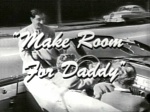 Make Room for Daddy (1953-1956) – The syndication package and official DVDs of The Danny Thomas Show begin with the show’s fourth season (1956-1957). I’d never seen anything of it until fairly recently, but I enjoyed it, and it got me curious about those missing three seasons. During that period, it was known as Make Room for Daddy, a sitcom about a nightclub singer, his homemaker wife and their two small children. You have to dig a little to find episodes of Daddy, but those I’ve seen are terrific. The most obvious difference between Daddy and the Thomas Show is the presence of Jean Hagen as Danny’s wife. Hagen and Thomas didn’t get along, and as soon as her three-year contract was up, she was gone like spit on a skillet. Surprisingly, she really doesn’t make a very vivid impression in those episodes of Daddy (maybe that’s why she was so unhappy, I don’t know). What does distinguish them are the performances of the children, Sherry Jackson and especially Rusty Hamer. In the first season, Hamer is so tiny that you’d hardly expect him to know his lines, but in fact his comic timing and delivery are outstanding, and he regularly gets bigger laughs than the star. In later seasons, he’s less compelling as he gets older, less cute and less precocious (and as the show truly becomes The Danny Thomas Show in every sense) But the talent is undeniably there, which makes his 1990 suicide all the more tragic. He’s hardly the only thing that’s appealing about Make Room for Daddy, which benefits from some sharp writing as well as Sheldon Leonard’s flair for sitcom production. But he’s definitely the most memorable.
Make Room for Daddy (1953-1956) – The syndication package and official DVDs of The Danny Thomas Show begin with the show’s fourth season (1956-1957). I’d never seen anything of it until fairly recently, but I enjoyed it, and it got me curious about those missing three seasons. During that period, it was known as Make Room for Daddy, a sitcom about a nightclub singer, his homemaker wife and their two small children. You have to dig a little to find episodes of Daddy, but those I’ve seen are terrific. The most obvious difference between Daddy and the Thomas Show is the presence of Jean Hagen as Danny’s wife. Hagen and Thomas didn’t get along, and as soon as her three-year contract was up, she was gone like spit on a skillet. Surprisingly, she really doesn’t make a very vivid impression in those episodes of Daddy (maybe that’s why she was so unhappy, I don’t know). What does distinguish them are the performances of the children, Sherry Jackson and especially Rusty Hamer. In the first season, Hamer is so tiny that you’d hardly expect him to know his lines, but in fact his comic timing and delivery are outstanding, and he regularly gets bigger laughs than the star. In later seasons, he’s less compelling as he gets older, less cute and less precocious (and as the show truly becomes The Danny Thomas Show in every sense) But the talent is undeniably there, which makes his 1990 suicide all the more tragic. He’s hardly the only thing that’s appealing about Make Room for Daddy, which benefits from some sharp writing as well as Sheldon Leonard’s flair for sitcom production. But he’s definitely the most memorable.
…………………………………………………………………..
 Racket Squad (1951-1953) – Hal Roach Studios had a wonderful twenty-year golden age from roughly 1918 to 1938, producing some of the most beloved comedies in film history. But the studio limped into the 1950s as a hub for some very low-rent television production, much of it pretty bad (watch any episode of The Trouble with Father to see how painful 1950s TV could be). Racket Squad was one of its few successes, and ironically the dim lighting and skimpy sets helped rather than hurt it. The show looks so cheap that you pity the people participating in it, but the rock-bottom budget creates a noirish look that’s just perfect for Racket Squad’s shadowy underworld of scam artists and the bunko schemes they run in the bad part of town. The con games are patiently dramatized in full detail, and are sometimes elaborate. Unlike almost every other crime show, Racket Squad is more about the workings of a criminal operation than about the process of gathering evidence and catching bad guys. In fact, the “squad” consists of one officer, “Captain Braddock” (Reed Hadley), who mainly just narrates each episode before stepping in during the final scene to nab the con man. Hadley delivers his lines as if he’s doing a radio drama, clearly enunciating every syllable in a rich velvety voice, and while some will snicker at the old-timey style of his performance, he’s one of my favorite things about the show. You kind of need to be in the mood for Racket Squad. But I don’t think I’ve seen a bad episode yet.
Racket Squad (1951-1953) – Hal Roach Studios had a wonderful twenty-year golden age from roughly 1918 to 1938, producing some of the most beloved comedies in film history. But the studio limped into the 1950s as a hub for some very low-rent television production, much of it pretty bad (watch any episode of The Trouble with Father to see how painful 1950s TV could be). Racket Squad was one of its few successes, and ironically the dim lighting and skimpy sets helped rather than hurt it. The show looks so cheap that you pity the people participating in it, but the rock-bottom budget creates a noirish look that’s just perfect for Racket Squad’s shadowy underworld of scam artists and the bunko schemes they run in the bad part of town. The con games are patiently dramatized in full detail, and are sometimes elaborate. Unlike almost every other crime show, Racket Squad is more about the workings of a criminal operation than about the process of gathering evidence and catching bad guys. In fact, the “squad” consists of one officer, “Captain Braddock” (Reed Hadley), who mainly just narrates each episode before stepping in during the final scene to nab the con man. Hadley delivers his lines as if he’s doing a radio drama, clearly enunciating every syllable in a rich velvety voice, and while some will snicker at the old-timey style of his performance, he’s one of my favorite things about the show. You kind of need to be in the mood for Racket Squad. But I don’t think I’ve seen a bad episode yet.
………………………………………………………………………….
 The Real McCoys (1957-1963) – TV history is crowded with situation comedies that never make you laugh, but which are beloved anyway for the characters in them. I usually hate those shows: I might be the only TV buff in America who can’t stand I Dream of Jeannie, Bewitched, The Munsters, Hogan’s Heroes and the rest of those contrived, heavily laugh-tracked sitcoms. To me, they’re just not funny, and the only interesting character in the lot runs a concentration camp. Maybe I’m just cold on that whole era, because there are sitcoms of the Eisenhower years that aren’t laugh riots either, yet I have far more patience with them (Bachelor Father and The Donna Reed Show, for example). The Real McCoys is usually good for a smile, at least, and I really love the characters in it. In fact, I guess I love The Real McCoys the way everyone else loves The Andy Griffith Show. Americana, country people and rural values all appeal to me. The McCoys are a family of West Virginians who’ve inherited a farm in California’s San Fernando Valley, which was largely agricultural back then. Walter Brennan is his crotchety best as family patriarch Amos McCoy, but regular viewers soon discover that the character is confined by sitcom conventions. You’ll see irascible Amos, headstrong Amos, contrite Amos and reflective Amos, roughly in that order and seldom in any other varieties, but he’s very endearing. Even more lovable is Kathy Nolan as the young wife of the family, and her departure after the fifth season thrust a pitchfork through the heart of the show. Unforgivably, her character’s absence would go basically unexplained in the sixth and final season— not that anyone was paying attention by then, as the show had been moved into a timeslot against Bonanza, which destroyed it in the ratings. But really, the producers’ indifference had killed it already. In its early seasons, The Real McCoys is a pretty good little sitcom, with the potential to be much more. Yes, the scripts are usually boilerplate and it’s lumbered with a laugh track it doesn’t need, but there’s also a sweetness that’s missing from most of TV’s funnier and better-remembered comedies.
The Real McCoys (1957-1963) – TV history is crowded with situation comedies that never make you laugh, but which are beloved anyway for the characters in them. I usually hate those shows: I might be the only TV buff in America who can’t stand I Dream of Jeannie, Bewitched, The Munsters, Hogan’s Heroes and the rest of those contrived, heavily laugh-tracked sitcoms. To me, they’re just not funny, and the only interesting character in the lot runs a concentration camp. Maybe I’m just cold on that whole era, because there are sitcoms of the Eisenhower years that aren’t laugh riots either, yet I have far more patience with them (Bachelor Father and The Donna Reed Show, for example). The Real McCoys is usually good for a smile, at least, and I really love the characters in it. In fact, I guess I love The Real McCoys the way everyone else loves The Andy Griffith Show. Americana, country people and rural values all appeal to me. The McCoys are a family of West Virginians who’ve inherited a farm in California’s San Fernando Valley, which was largely agricultural back then. Walter Brennan is his crotchety best as family patriarch Amos McCoy, but regular viewers soon discover that the character is confined by sitcom conventions. You’ll see irascible Amos, headstrong Amos, contrite Amos and reflective Amos, roughly in that order and seldom in any other varieties, but he’s very endearing. Even more lovable is Kathy Nolan as the young wife of the family, and her departure after the fifth season thrust a pitchfork through the heart of the show. Unforgivably, her character’s absence would go basically unexplained in the sixth and final season— not that anyone was paying attention by then, as the show had been moved into a timeslot against Bonanza, which destroyed it in the ratings. But really, the producers’ indifference had killed it already. In its early seasons, The Real McCoys is a pretty good little sitcom, with the potential to be much more. Yes, the scripts are usually boilerplate and it’s lumbered with a laugh track it doesn’t need, but there’s also a sweetness that’s missing from most of TV’s funnier and better-remembered comedies.
………………………………………………………………………..
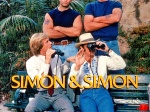 Simon and Simon (1981-1989) – I only started watching this show when I learned that it was set in my old home town of San Diego. After being spoiled by the fabulous wall-to-wall location shooting of The Streets of San Francisco, I was disappointed to find very little of San Diego in Simon and Simon’s first season (despite what Wikipedia says). I also found the show to be pretty unfocused in its early episodes. But then it began to grow on me. The two leads are likable and have a good rapport with each other; Gerald McRaney is particularly good. I don’t usually care much for detective shows, but this one takes itself lightly, it has a sense of humor, and it avoids going overboard with gunplay and socks to the jaw. It’s about a pair of brothers who run a small detective agency. Like Jim Rockford of The Rockford Files, Simon & Simon always get their man but you have to wonder if they’ll be able to make the next car payment. Come to think of it, this is a great detective show for female viewers; not because the two leads are pretty-boys (they aren’t), but because the show is more interested in the relationship between them than in high-speed chases and exploding sports cars. That’s not to say that this is the thirtysomething of detective shows, only that neither of these guys is another Mike Hammer— nor do they need to be. I only watch Simon and Simon about once a month, but I always look forward to another hour with Rick and A.J. Just skip the first nine or ten episodes.
Simon and Simon (1981-1989) – I only started watching this show when I learned that it was set in my old home town of San Diego. After being spoiled by the fabulous wall-to-wall location shooting of The Streets of San Francisco, I was disappointed to find very little of San Diego in Simon and Simon’s first season (despite what Wikipedia says). I also found the show to be pretty unfocused in its early episodes. But then it began to grow on me. The two leads are likable and have a good rapport with each other; Gerald McRaney is particularly good. I don’t usually care much for detective shows, but this one takes itself lightly, it has a sense of humor, and it avoids going overboard with gunplay and socks to the jaw. It’s about a pair of brothers who run a small detective agency. Like Jim Rockford of The Rockford Files, Simon & Simon always get their man but you have to wonder if they’ll be able to make the next car payment. Come to think of it, this is a great detective show for female viewers; not because the two leads are pretty-boys (they aren’t), but because the show is more interested in the relationship between them than in high-speed chases and exploding sports cars. That’s not to say that this is the thirtysomething of detective shows, only that neither of these guys is another Mike Hammer— nor do they need to be. I only watch Simon and Simon about once a month, but I always look forward to another hour with Rick and A.J. Just skip the first nine or ten episodes.
………………………………………………………………..
 Spartacus (2010-2013) – I don’t watch super-hero movies. I get bored with the endless cartoony fight scenes, thudding soundtracks and oversaturated special effects. That’s why I was surprised by how well I liked Starz’ Spartacus series. It’s got all of the above, with lots of gratuitous sex and brutality besides. Maybe what saved the show for me was that it’s rooted in history rather than in comic books. I’d found HBO’s expensive series Rome to be lugubrious and uninvolving, but Spartacus has you empathizing with the characters, while doing a better job of explaining the social dynamics of the Roman Empire than you’d expect. But make no mistake: this is anything but dry and intellectual material. You’re seldom more than ten minutes away from the next bloody gladiator sword fight, and you’ll get plenty of naked slave girls, back-stabbing palace intrigue and savage arena battles, all with just enough variation to keep the material fresh. (There are way too many shots of blood spurting out of guys’ mouths in sloooooooow motion, though.) The first season (Spartacus: Blood and Sand) is the best, thanks largely to Andy Whitfield in the leading role. Tragically, unbelievably, Whitfield developed lymphoma before the first season was even off the air, and died a year or so later. He was replaced in the second and third seasons by Liam McIntyre, who’s good but not quite up to Whitfield’s standard. Several of the other actors (notably Peter Mensah) are superb. The final (third) season is almost a re-tooling of the show, in which Spartacus and his gladiator friends lead a slave revolt across Italy, climaxing in a showdown with the army of Julius Caesar. If you know your ancient history, you know how the story ends. That ultimate confrontation is as good as anything in the whole series, but that final season suffers from the absence of some key characters who’d been killed off in earlier seasons. Perhaps to make up for their loss, a lot of attention is lavished on the young Caesar, so much so that I hoped the series would go marching along as a showcase for his adventures, but alas, no.
Spartacus (2010-2013) – I don’t watch super-hero movies. I get bored with the endless cartoony fight scenes, thudding soundtracks and oversaturated special effects. That’s why I was surprised by how well I liked Starz’ Spartacus series. It’s got all of the above, with lots of gratuitous sex and brutality besides. Maybe what saved the show for me was that it’s rooted in history rather than in comic books. I’d found HBO’s expensive series Rome to be lugubrious and uninvolving, but Spartacus has you empathizing with the characters, while doing a better job of explaining the social dynamics of the Roman Empire than you’d expect. But make no mistake: this is anything but dry and intellectual material. You’re seldom more than ten minutes away from the next bloody gladiator sword fight, and you’ll get plenty of naked slave girls, back-stabbing palace intrigue and savage arena battles, all with just enough variation to keep the material fresh. (There are way too many shots of blood spurting out of guys’ mouths in sloooooooow motion, though.) The first season (Spartacus: Blood and Sand) is the best, thanks largely to Andy Whitfield in the leading role. Tragically, unbelievably, Whitfield developed lymphoma before the first season was even off the air, and died a year or so later. He was replaced in the second and third seasons by Liam McIntyre, who’s good but not quite up to Whitfield’s standard. Several of the other actors (notably Peter Mensah) are superb. The final (third) season is almost a re-tooling of the show, in which Spartacus and his gladiator friends lead a slave revolt across Italy, climaxing in a showdown with the army of Julius Caesar. If you know your ancient history, you know how the story ends. That ultimate confrontation is as good as anything in the whole series, but that final season suffers from the absence of some key characters who’d been killed off in earlier seasons. Perhaps to make up for their loss, a lot of attention is lavished on the young Caesar, so much so that I hoped the series would go marching along as a showcase for his adventures, but alas, no.
……………………………………………………………………………..
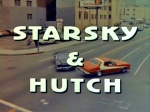 Starsky and Hutch (1975-1979) – This show’s whole premise eventually became a cliché: a pair of snarky undercover cops in a fast car bust some heads and bring down the bad guys, week after week. Worse, you really have to work overtime suspending disbelief when watching this show. Starsky and Hutch never have to fill out reports, their car always looks pristine, and most of their investigative work consists of asking their Skid Row pal Huggy Bear what the word on the street is. But in the hands of producers Aaron Spelling and Leonard Goldberg, this wheezy material becomes a lot of fun. The stars have good chemistry, the plots are just involved enough to keep you engaged, and there are car chases and fist fights galore. I’m fascinated by all the location shots in the most wretched areas of 1970s downtown Los Angeles, and I love Lalo Schifrin’s rumbling, ominous theme music and how the stories race along from start to finish. Better yet, the show is a goldmine for appearances by future stars on the rise (Suzanne Somers, Jeff Goldblum, John Ritter) and past stars on the way down (Lola Albright, Joan Blondell, Jose Ferrer, Sylvia Sidney). It’s the television equivalent of a greasy burger and fries, but hey… sometimes that’s what you’re hungry for.
Starsky and Hutch (1975-1979) – This show’s whole premise eventually became a cliché: a pair of snarky undercover cops in a fast car bust some heads and bring down the bad guys, week after week. Worse, you really have to work overtime suspending disbelief when watching this show. Starsky and Hutch never have to fill out reports, their car always looks pristine, and most of their investigative work consists of asking their Skid Row pal Huggy Bear what the word on the street is. But in the hands of producers Aaron Spelling and Leonard Goldberg, this wheezy material becomes a lot of fun. The stars have good chemistry, the plots are just involved enough to keep you engaged, and there are car chases and fist fights galore. I’m fascinated by all the location shots in the most wretched areas of 1970s downtown Los Angeles, and I love Lalo Schifrin’s rumbling, ominous theme music and how the stories race along from start to finish. Better yet, the show is a goldmine for appearances by future stars on the rise (Suzanne Somers, Jeff Goldblum, John Ritter) and past stars on the way down (Lola Albright, Joan Blondell, Jose Ferrer, Sylvia Sidney). It’s the television equivalent of a greasy burger and fries, but hey… sometimes that’s what you’re hungry for.
………………………………………………………………………….
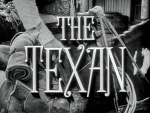 The Texan (1958-1960) – Taciturn western heroes were all over the dial during the Eisenhower/Kennedy era. Most of them failed to really stand out, but one who does is Rory Calhoun of The Texan. He’s got a penetrating stare and when he barks a command, people jump. In the very next scene, he can project warmth and a calm sort of amiability. He’s got a lot of star power, and I don’t know why he isn’t regarded more highly today. Maybe he needed to be a couple of inches taller and twenty pounds heavier, I don’t know. But he carries himself as if he could mop the floor with Steve McQueen of Wanted: Dead or Alive, and I bet he could do it. Calhoun co-produced The Texan himself and it’s a first-class show, with very solid scripts and good performances. I hear it began fraying at the seams in the second season (as audiences flipped the dial to ABC for Cheyenne). But I sure like what I’ve seen. You probably already need to like TV westerns to get into The Texan. But if you do, you may have already seen your share of shows that never got very compelling because they lacked a rugged, dynamic star (I’d put Bronco, Destry, Tate and Cimarron City in that category). Calhoun really owns every scene in which he appears— he’s right up there with Richard Boone of Have Gun Will Travel in that regard— and that kind of power makes The Texan a true standout.
The Texan (1958-1960) – Taciturn western heroes were all over the dial during the Eisenhower/Kennedy era. Most of them failed to really stand out, but one who does is Rory Calhoun of The Texan. He’s got a penetrating stare and when he barks a command, people jump. In the very next scene, he can project warmth and a calm sort of amiability. He’s got a lot of star power, and I don’t know why he isn’t regarded more highly today. Maybe he needed to be a couple of inches taller and twenty pounds heavier, I don’t know. But he carries himself as if he could mop the floor with Steve McQueen of Wanted: Dead or Alive, and I bet he could do it. Calhoun co-produced The Texan himself and it’s a first-class show, with very solid scripts and good performances. I hear it began fraying at the seams in the second season (as audiences flipped the dial to ABC for Cheyenne). But I sure like what I’ve seen. You probably already need to like TV westerns to get into The Texan. But if you do, you may have already seen your share of shows that never got very compelling because they lacked a rugged, dynamic star (I’d put Bronco, Destry, Tate and Cimarron City in that category). Calhoun really owns every scene in which he appears— he’s right up there with Richard Boone of Have Gun Will Travel in that regard— and that kind of power makes The Texan a true standout.








